

Compact Muon Solenoid
LHC, CERN
| CMS-PAS-B2G-16-019 | ||
| Search for heavy vector-like quarks decaying to same-sign dileptons | ||
| CMS Collaboration | ||
| March 2017 | ||
| Abstract: A search for the production of heavy partners of the top quark with charge 5/3 decaying to same-sign dileptons is presented. The data sample was collected at a center of mass energy of √s= 13 TeV by the CMS experiment at the Large Hadron Collider in 2016 and corresponds to an integrated luminosity of 35.9 fb−1. The same-sign dilepton final state has three main sources of background: background from prompt standard model processes, background from events where the charge of one of the leptons is misidentified, and background from non-prompt or fake leptons. No significant excess is seen above the expected background and lower limits are placed on the X5/3 mass of 1.16 (1.10) TeV for right (left) handed chirality particle while the expected limits are 1.20 (1.15) TeV for a right (left) handed X5/3. | ||
| Links: CDS record (PDF) ; inSPIRE record ; CADI line (restricted) ; | ||
| Figures | |
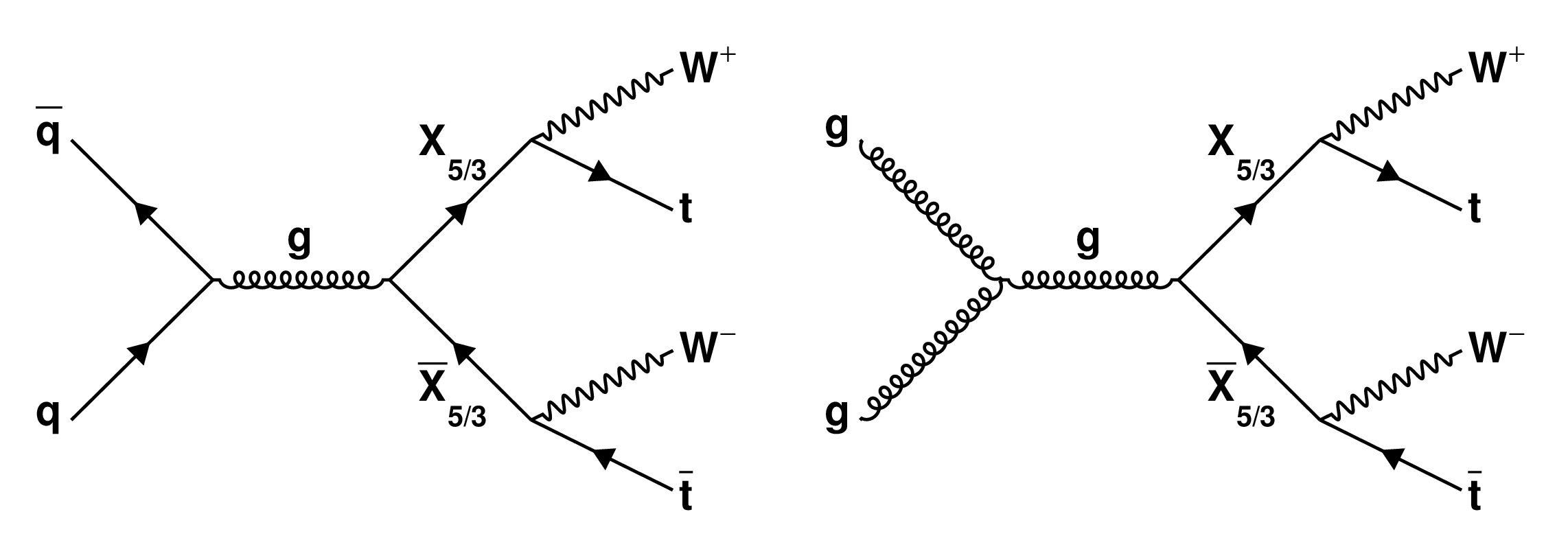
png pdf |
Figure 1:
Feynman diagrams for the production of pairs of X5/3particles via QCD processes. |
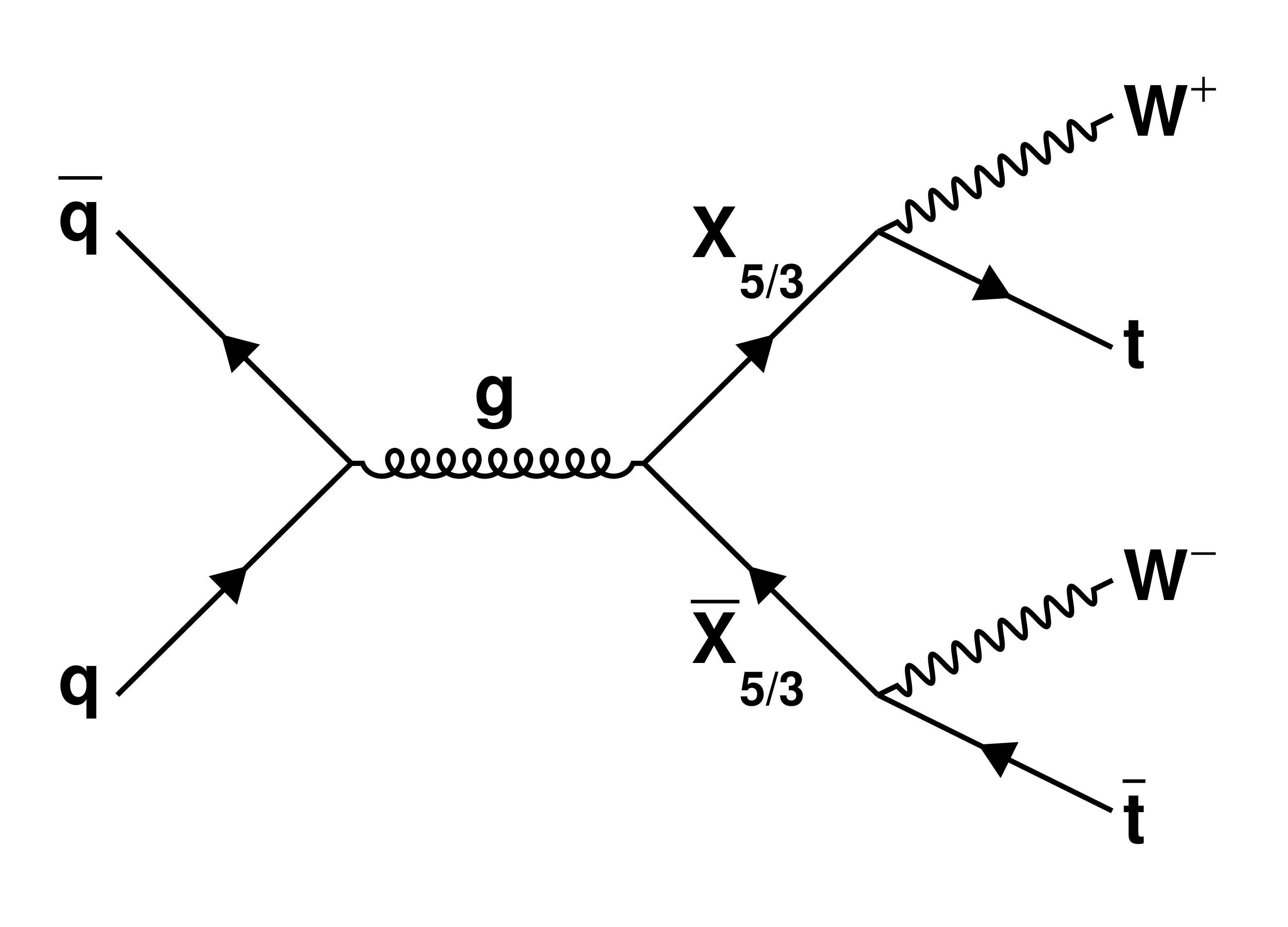
png pdf |
Figure 1-a:
Feynman diagram for the production of pairs of X5/3particles via QCD processes. |

png pdf |
Figure 1-b:
Feynman diagram for the production of pairs of X5/3particles via QCD processes. |

png pdf |
Figure 2:
The HlepT distributions after the same-sign dilepton selection, Z/quarkonia lepton invariant mass vetoes, and requiring at least two AK4 jets in the event. The bottom panel on all plots shows the difference between the observed and the predicted number of events in that bin divided by the total uncertainty (σ). The total uncertainty is calculated as the sum in quadrature of the statistical uncertainty on the observed measurement and the uncertainty, including both statistical and systematic, on the background. |
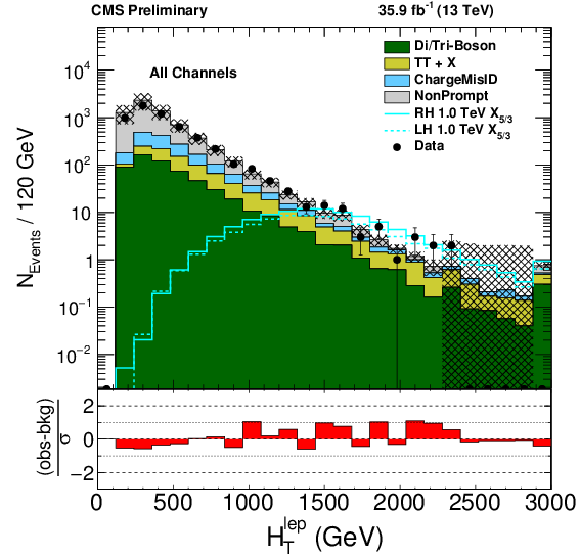
png pdf |
Figure 2-a:
The HlepT all-channel distribution after the same-sign dilepton selection, Z/quarkonia lepton invariant mass vetoes, and requiring at least two AK4 jets in the event. |

png pdf |
Figure 2-b:
The HlepT ee distribution after the same-sign dilepton selection, Z/quarkonia lepton invariant mass vetoes, and requiring at least two AK4 jets in the event. |

png pdf |
Figure 2-c:
The HlepT eμ distribution after the same-sign dilepton selection, Z/quarkonia lepton invariant mass vetoes, and requiring at least two AK4 jets in the event. |
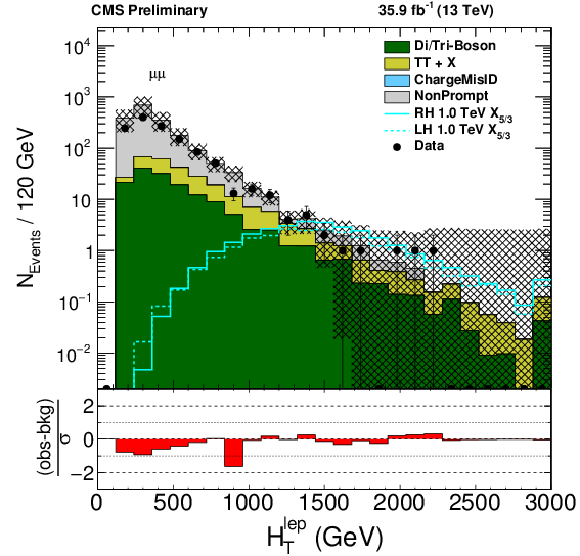
png pdf |
Figure 2-d:
The HlepT μμ distribution after the same-sign dilepton selection, Z/quarkonia lepton invariant mass vetoes, and requiring at least two AK4 jets in the event. |

png pdf |
Figure 3:
95% CL observed and expected limits for a left-handed (left) and right-handed (right) X5/3 for all channels combined. The theoretical uncertainty on the signal cross section is shown as a red band around the central prediction. |
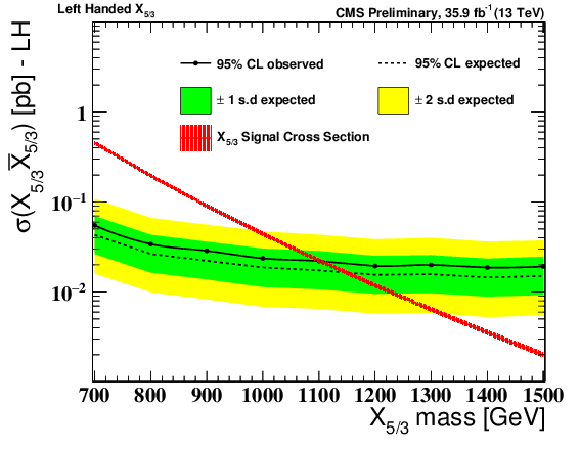
png pdf |
Figure 3-a:
95% CL observed and expected limits for a left-handed X5/3 for all channels combined. The theoretical uncertainty on the signal cross section is shown as a red band around the central prediction. |
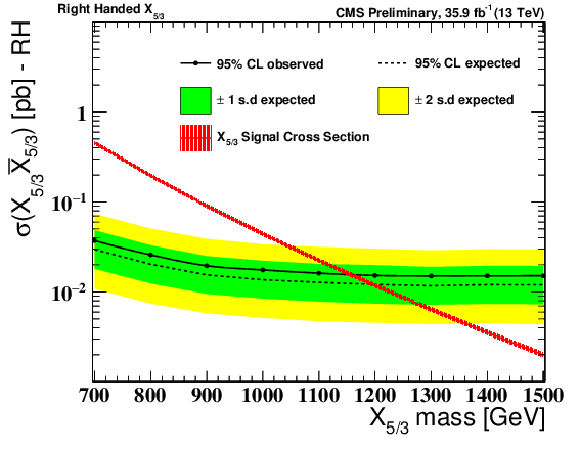
png pdf |
Figure 3-b:
95% CL observed and expected limits for a right-handed X5/3 for all channels combined. The theoretical uncertainty on the signal cross section is shown as a red band around the central prediction. |
| Tables | |
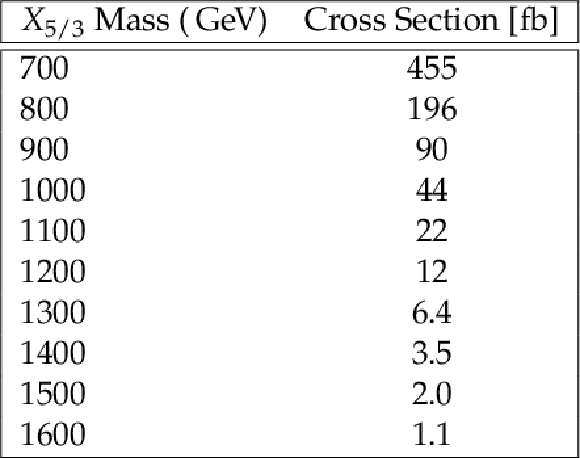
png pdf |
Table 1:
X5/3signal samples and their cross sections. Samples for both LH and RH chiralities were generated for the different mass points. |
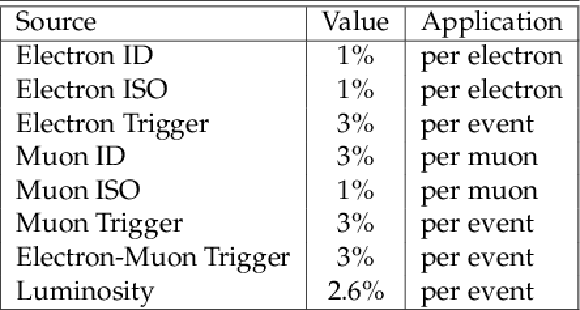
png pdf |
Table 2:
Details of systematic uncertainties applied for lepton triggering, identification ("ID''), isolation ("ISO''), and luminosity. |
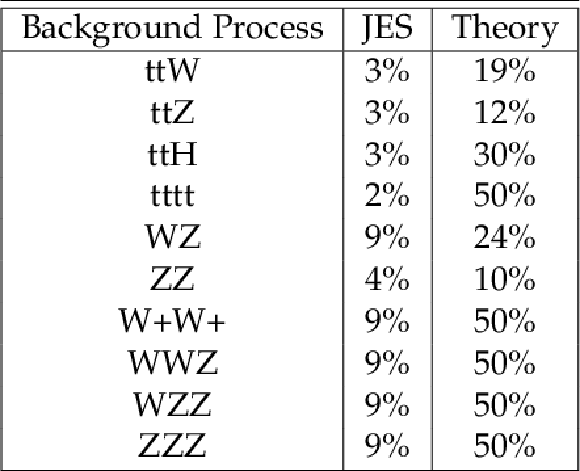
png pdf |
Table 3:
Systematic uncertainties associated with the background processes which we take from simulation. "JES'' refers to the uncertainty from the jet energy scale while "Theory'' refers to uncertainties from the cross section normalization and choice of PDF. |

png pdf |
Table 4:
Summary of yields from prompt same-sign dilepton Monte Carlo (PSS MC), same-sign non-prompt (NonPrompt), and opposite-sign prompt (ChargeMisID) backgrounds after the full analysis selection. Also shown are the number of expected events for a right handed 1000 GeV X5/3. The errors include both statistical and all systematic uncertainties. |
| Summary |
| In summary, we have performed a search for an exotic top partner with charge 5/3 decaying to same-sign dileptons using 35.9 fb−1 of data collected by the CMS experiment at √s= 13 TeV. No significant excess above the expected values is seen and observed (expected) limits are placed on the X5/3 mass of 1.16 (1.20) TeV for a right handed X5/3 and 1.10 (1.15) TeV for a left handed X5/3. |
| References | ||||
| 1 | A. De Simone, O. Matsedonskyi, R. Rattazzi, and A. Wulzer | A First Top Partner Hunter's Guide | JHEP 04 (2013) 004 | 1211.5663 |
| 2 | J. Mrazek and A. Wulzer | A Strong Sector at the LHC: Top Partners in Same-Sign Dileptons | PRD 81 (2010) 075006 | 0909.3977 |
| 3 | G. Dissertori, E. Furlan, F. Moortgat, and P. Nef | Discovery potential of top-partners in a realistic composite Higgs model with early LHC data | JHEP 09 (2010) 019 | 1005.4414 |
| 4 | R. Contino and G. Servant | Discovering the top partners at the LHC using same-sign dilepton final states | JHEP 06 (2008) 026 | 0801.1679 |
| 5 | A. Azatov and J. Galloway | Light Custodians and Higgs Physics in Composite Models | PRD 85 (2012) 055013 | 1110.5646 |
| 6 | CMS Collaboration | Search for top quark partners with charge 5/3 at √s= 13 TeV | CMS-PAS-B2G-15-006 | CMS-PAS-B2G-15-006 |
| 7 | ATLAS Collaboration Collaboration | Search for new physics using events with b-jets and a pair of same charge leptons in 3.2 fb−1 of pp collisions at √s= 13 TeV with the ATLAS detector | Technical Report ATLAS-CONF-2016-032, CERN, Geneva, Jun | |
| 8 | CMS Collaboration | The CMS experiment at the CERN LHC | JINST 3 (2008) S08004 | CMS-00-001 |
| 9 | J. Alwall et al. | The automated computation of tree-level and next-to-leading order differential cross sections, and their matching to parton shower simulations | JHEP 07 (2014) 079 | 1405.0301 |
| 10 | P. Artoisenet, R. Frederix, O. Mattelaer, and R. Rietkerk | Automatic spin-entangled decays of heavy resonances in Monte Carlo simulations | JHEP 03 (2013) 015 | 1212.3460 |
| 11 | M. Czakon and A. Mitov | Top++: A Program for the Calculation of the Top-Pair Cross-Section at Hadron Colliders | CPC 185 (2014) 2930 | |
| 12 | M. Czakon, P. Fiedler, and A. Mitov | Total Top-Quark Pair-Production Cross Section at Hadron Colliders Through O(α4S) | PRL 110 (2013) 252004 | |
| 13 | M. Czakon and A. Mitov | NNLO corrections to top pair production at hadron colliders: the quark-gluon reaction | JHEP 01 (2013) 080 | |
| 14 | M. Czakon and A. Mitov | NNLO corrections to top-pair production at hadron colliders: the all-fermionic scattering channels | JHEP 12 (2012) 054 | |
| 15 | P. Barnreuther, M. Czakon, and A. Mitov | Percent Level Precision Physics at the Tevatron: First Genuine NNLO QCD Corrections to qˉq→tˉt+X | PRL 109 (2012) 132001 | |
| 16 | M. Cacciari et al. | Top-pair production at hadron colliders with next-to-next-to-leading logarithmic soft-gluon resummation | PLB 710 (2012) 612 | |
| 17 | J. Alwall et al. | Comparative study of various algorithms for the merging of parton showers and matrix elements in hadronic collisions | EPJC 53 (2008) 473 | 0706.2569 |
| 18 | R. Frederix and S. Frixione | Merging meets matching in MC@NLO | JHEP 12 (2012) 061 | 1209.6215 |
| 19 | S. Frixione, P. Nason, and C. Oleari | Matching NLO QCD computations with Parton Shower simulations: the POWHEG method | JHEP 11 (2007) 070 | 0709.2092 |
| 20 | T. Sjostrand, S. Mrenna, and P. Z. Skands | A Brief Introduction to PYTHIA 8.1 | CPC 178 (2008) 852 | 0710.3820 |
| 21 | T. Sjostrand et al. | An Introduction to PYTHIA 8.2 | CPC 191 (2015) 159 | 1410.3012 |
| 22 | NNPDF Collaboration | Parton distributions for the LHC Run II | JHEP 04 (2015) 040 | |
| 23 | P. Skands, S. Carrazza, and J. Rojo | Tuning PYTHIA 8.1: the Monash 2013 Tune | EPJC 74 (2014) 3024 | 1404.5630 |
| 24 | CMS Collaboration Collaboration | Investigations of the impact of the parton shower tuning in Pythia 8 in the modelling of t¯t at √s= 8 and 13 TeV | Technical Report CMS-PAS-TOP-16-021, CERN, Geneva | |
| 25 | GEANT4 Collaboration | GEANT4: A Simulation toolkit | NIMA 506 (2003) 250 | |
| 26 | CMS Collaboration | Particle-flow event reconstruction in CMS and performance for jets, taus, and EmissT | CDS | |
| 27 | CMS Collaboration | Commissioning of the particle-flow event with the first LHC collisions recorded in the CMS detector | CDS | |
| 28 | CMS Collaboration | Performance of Electron Reconstruction and Selection with the CMS Detector in Proton-Proton Collisions at √s= 8 TeV | JINST 10 (2015) P06005 | CMS-EGM-13-001 1502.02701 |
| 29 | CMS Collaboration Collaboration | CMS Tracking Performance Results from Early LHC Operation | EPJC 70 (Jul, 2010) 1165. 29 p | |
| 30 | W. Adam, R. Fruhwirth, A. Strandlie, and T. Todorov | Reconstruction of electrons with the Gaussian sum filter in the CMS tracker at LHC | J. Phys G 31 (2005) N9 | physics/0306087 |
| 31 | CMS Collaboration | Measurement of the Inclusive W and Z Production Cross Sections in pp Collisions at √s= 7 TeV | JHEP 10 (2011) 132 | CMS-EWK-10-005 1107.4789 |
| 32 | M. Cacciari, G. P. Salam, and G. Soyez | The anti-kt jet clustering algorithm | JHEP 04 (2008) 063 | 0802.1189 |
| 33 | CMS Collaboration | Determination of jet energy calibration and transverse momentum resolution in CMS | JINST 6 (2011) P11002 | CMS-JME-10-011 1107.4277 |
| 34 | CMS Collaboration | Search for new physics with same-sign isolated dilepton events with jets and missing transverse energy at the LHC | JHEP 06 (2011) 077 | CMS-SUS-10-004 1104.3168 |
| 35 | T. Muller, J. Ott, and J. Wagner-Kuhr | theta - a framework for template-based modeling and inference | 2010 | |

|
Compact Muon Solenoid LHC, CERN |

|

|

|

|

|

|